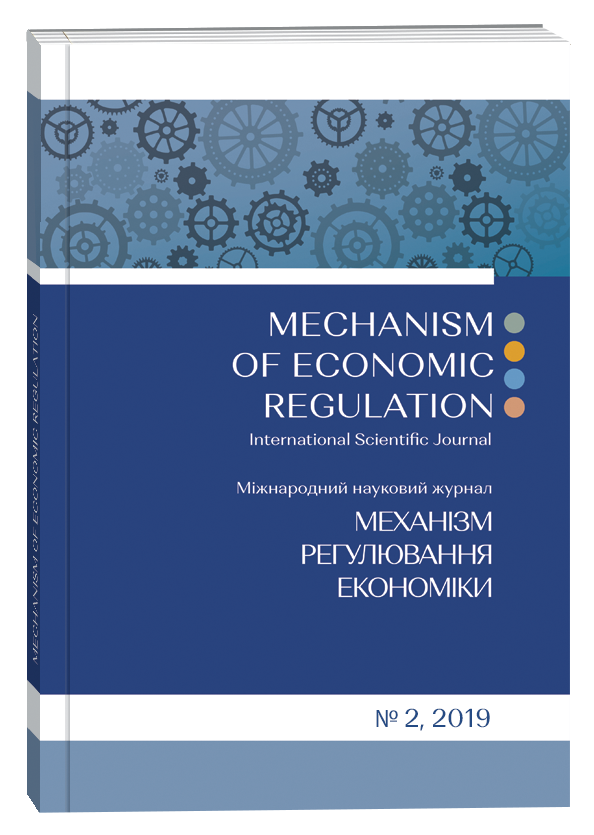ФОРМУВАННЯ ОРГАНІЗАЦІЙНО-ЕКОНОМІЧНОГО МЕХАНІЗМУ ЗАЛУЧЕННЯ ІНВЕСТИЦІЙ ДО РЕГІОНУ
Анотація
У сучасному світі питання задоволення потреби людей в енергії та екодеструктивності вплив енергетичного сектора на екологію планети стоїть дуже гостро. Існують методи оцінки збитку, який наноситься від традиційних джерел енергії, в той час як використання даної методики до поновлюваних джерел енергії не об'єктивно. Причина полягає в тому, що основний збиток навколишньому середовищу від традиційних джерел енергії наноситься під час виробництва електрики, за рахунок використання енергетичних ресурсів. У той же час, поновлювані джерела енергії не використовують енергетичних ресурсів для виробництва електрики, тому для оцінки збитку поновлюваних джерел енергії необхідно аналізувати їх життєвий цикл. Були розглянуті дослідження Al-mulali, Apergis and Payne, Dogan і Turkekul, Menegak якi підтверджують наявності взаємозв'язку між зростанням економічних показників (валовий внутрішній продукт) і зростанням в енергії, виробленої поновлюваними джерелами енергії. У статті викладено екодеструктивний вплив поновлюваних джерел енергії на етапах і фазах життєвого циклу для поновлюваних джерел енергії. Було розглянуто сумарне споживання електроенергії в світі за період 1973-2016 рр. Наведено порівняння традиційних і поновлюваних джерел енергії за термінами служби і життєвого циклу, а також детально розглянуті основні етапи і фази життєвого циклу поновлюваних джерел енергії. Показані етапи розробки, створення технології, експлуатації об'єктів, утилізації та переробки компонентів поновлюваних джерел енергії. Було розглянуто вплив поновлюваних джерел енергії на навколишнє середовище з точки зору резервуарів, водоймищ та конкретні ефекти наслідків використання об'єктів поновлюваних джерел енергії. З метою виявлення несприятливих факторів впливу, з точки зору екодеструктивного впливу, були розглянуті етапи структурного складу життєвого циклу поновлюваних джерел енергії для пошуку можливих шляхів їх усунення на кожному етапі.
Посилання
World Bank Statistics [Electronic resource]. Renewable energy consumption (% of total final energy consumption). – Accessed mode : data.worldbank.org.
Sawin, J. L. Renewables 2019 / Sawin J. L., Sverrisson F., Chawla K., Lins C., Adib R., Hullin M., & Wright G. Global status report 2019. – Paris : REN21 Secretariat REN21.
Akella, A. K. Social, economical and environmental impacts of renewable energy systems / A. K. Akella, R. P. Saini, M. P. Sharma // Renewable Energy. – 2009. – Т. 34. – № 2. – С. 390–396.
International Energy Agency. Benign energy? The environmental implications of renewables. – Paris : OECD. – 1998. – Р. 15, 45.
Al-mulali, U. Exploring the relationship between urbanization, energy consumption, and CO2 emission in MENA countries / U. Al-mulali // Renewable and Sustainable Energy Reviews. – 2013. – Т. 23. – С. 107–112.
Apergis, N. Renewable energy, output, CO2 emissions, and fossil fuel prices in Central America: Evidence from a nonlinear panel smooth transition vector error correction model / N. Apergis, J. E. Payne // Energy Economics. – 2014. – Т. 42. – С. 226–232.
Dogan, E. The influence of renewable and non-renewable energy consumption and real income on CO2 emissions in the USA: evidence from structural break tests / E. Dogan, I. Ozturk // Environmental Science and Pollution Research. – 2017. – Т. 24. – № 11. – С. 10846–10854.
Menegaki, A. N. Growth and renewable energy in Europe: a random effect model with evidence for neutrality hypothesis / A. N. Menegaki // Energy economics. – 2011. – Т. 33. – № 2. – С. 257–263.
Кологривов, Я. І. Стратегічний розвиток підприємств енергетики: циклічність розвитку та життєвий цикл / Я. І. Кологривов // Економічний вісник Національного технічного університету України Київський політехнічний інститут. – 2014. – № 11. – С. 146–150.
Дерейко, Х. О. Оцінка екологічного впливу використання сонячної енергетики за методологією оцінювання життєвого циклу / Х. О. Дерейко, Н. І. Козяр, З. С. Одноріг. – 2015.
Гавриш, О. А. Апробація системи оцінювання альтернативних технологій отримання електроенергії / О. А. Гавриш, С. В. Нараєвський. – 2014.
Прийменко, С. А. Еколого-економічні засади управління життєвим циклом енергетичного продукту : дис. … канд. екон. наук : 08.00.06 [Електронний ресурс] / Прийменко Світлана Анатоліївна. Державний вищий навчальний заклад «Національний гірничий університет». – Дніпропетровськ, 2015. – Режим доступу : http://ir.nmu.org.ua/bitstream/handle/123456789/146747/Дисертація_Прийменко%20С.А.pdf?sequ ence=3&isAllowed=y.
Матюшенко, О. І. Життєвий цикл підприємства: сутність, моделі, оцінка / О. І. Матюшенко // Проблеми економіки. – 2010. – № 4. – С. 82–91.
Energy Information Administration – EIA – Official Energy Statistics from the U.S. Government.
Енговатов, И. А. Вывод из эксплуатации ядерных установок (на примере блоков атомных станций) : учебное пособие / И. А. Енговатов, Б. К. Былкин. – М. : МГСУ, 2015. – 128 с.
Wu, D. W. Combined cooling, heating and power: a review / D. W. Wu, R. Z. Wang // Progress in energy and combustion science. – 2006. – Т. 32. – № 5–6. – С. 459–495.
Tremeac, B. Life cycle analysis of 4.5 MW and 250 W wind turbines / B. Tremeac, F. Meunier // Renewable and sustainable energy reviews. – 2009. – Т. 13. – № 8. – С. 2104–2110.
Raluy, R. G. Life-cycle assessment of desalination technologies integrated with energy production systems / R. G. Raluy et al. // Desalination. – 2004. – Т. 167. – С. 445–458.
Nouni, M. R. Techno-economics of micro-hydro projects for decentralized power supply in India / M. R. Nouni, S. C. Mullick, T. C. Kandpal // Energy Policy. – 2006. – Т. 34. – № 10. – С. 1161–1174.
Schleisner, L. Life cycle assessment of a wind farm and related externalities / L. Schleisner // Renewable energy. – 2000. – Т. 20. – № 3. – С. 279–288.
Ратнер, С. В. Перспективы развития солнечной энергетики в России: стоимостной анализ / С. В. Ратнер, В. В. Иосифов // Вестник УрФУ. – Серия: Экономика и управление. – 2014. – № 4. – 2014. –С. 52–62.
Guezuraga, B. Life cycle assessment of two different 2 MW class wind turbines / B. Guezuraga, R. Zauner, W. Pölz // Renewable Energy. – 2012. – Т. 37. – № 1. – С. 37–44.
The United States Geological Survey [Electronic resource]. Statistics, 2011. – Accessed mode : https://www.usgs.gov/.


